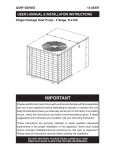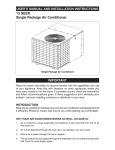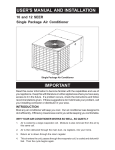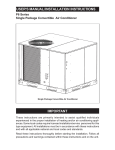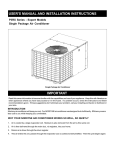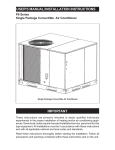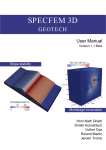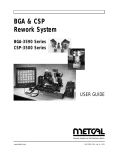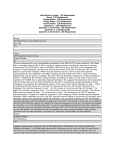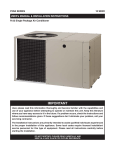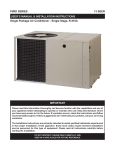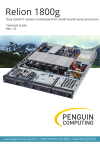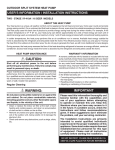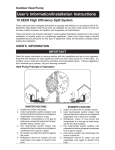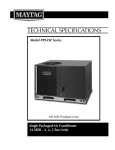Download USER`S MANUAL AND INSTALLATION INSTRUCTIONS 15 SEER 2
Transcript
USER’S MANUAL AND INSTALLATION INSTRUCTIONS 15 SEER 2-Stage R-410A Single Package Air Conditioner Single Package Air Conditioner IMPORTANT Read this owner information to become familiar with the capabilities and use of your appliance. Keep this with literature on other appliances where you have easy access to it in the future. If a problem occurs, check the instructions and follow recommendations given. If these suggestions don’t eliminate your problem, call your installing contractor or distributor in your area. INTRODUCTION Most any air conditioner will keep you cool. Our air conditioner was designed to do it efficiently. Efficiency means less cost to you while keeping you comfortable. WHY YOUR AIR CONDITIONER WORKS SO WELL, SO QUIETLY 1. Air is cooled by a large evaporator coil. Moisture is also removed from the air by this same coil. 2. Air is then delivered through the main duct, via registers, into your home. 3. Return air is drawn through the return register. 4. This air enters the unit, passes through the evaporator coil, is cooled and dehumidified. Then the cycle begins again. 2 The indoor blower will cycle on and off to maintain the indoor temperature at the desired heating level. SECTION 1. OWNER INFORMATION OPERATING INSTRUCTIONS To Operate Your Air Conditioner for Cooling— Thermostat — The 15 SEER Air Conditioner uses a special two speed compressor to achieve a high level of efficiency in a compact frame. A two stage cooling 24VAC thermostat can be used with these units. For the highest efficiency the use of a two-stage cooling thermostat is recommended. Refer to Figure 11 or 12 for a unit wiring diagram. Cooling Mode: 1. On a call for cooling the thermostat closes, applying 24VAC to the G and Y1 terminals on the control. This closes the compressor contactor, and the compressor operates on 1st stage. 2. If the thermostat is not satisfied in the required time, based on the operation of the two-stage cooling thermostat, Y2 will System Mode Fan Mode Temperature Selector Figure 1. Typical Thermostat 3. energize and the compressor will run at second stage. Refer to the thermostat installation instructions for the cooling profile. When the thermostat is satisfied, the G and Y terminals on the control board are de-energized opening the compressor contactor. To OperateYour Unit for Heating — (If optional heat accessory is installed.) 1. Set the thermostat system switch to HEAT or AUTO and the thermostat fan switch to AUTO. (See Figure 1) 2. Set the thermostat temperature to the desired temperature level using the temperature selector. Please refer to the separate user’s manual for complete thermostat programming instructions. To Shut Off Your Air Conditioner —Set the thermostat system switch to OFF and the thermostat fan switch to AUTO. (See Figure 1) The system will not operate, regardless of the thermostat temperature setting. To Operate the Indoor Blower Continuously— Set the thermostat fan switch to ON (See Figure 1) The indoor blower will start immediately, and will run continually until the fan switch is reset to AUTO. The continuous indoor blower operation can be obtained with the thermostat system switch set in any position, including OFF. The continuous indoor blower operation is typically used to circulate the indoor air to equalize a temperature unbalance due to a sun load, cooking, or fireplace operation. BEFORE YOU CALL A SERVICEMAN Let your serviceman check your system at the start of each air conditioning season. He will make sure it’s working right, clean or change filters and make any needed adjustments. In addition, follow these simple rules: 1. Never run your system without filter. If you do, the cooling coils will get dirty and may become clogged. 2. Set your thermostat at the comfort level you wish -- and then leave it alone. Let it control the operation of the air conditioning system. If you get chilly, turn it up a degree at a time until comfort is restored. 3. It takes longer for an air conditioner to cool your dwelling than it does for your furnace to heat it. Therefore, do not turn the unit on and expect a dramatic drop in temperature, at least not right away. If your home is hot and humid, the temperature will drop slowly. 4. Check your filters every ten days in summer to see if they are dirty. To keep them clean, use a mild solution of detergent and water on washable types. Replace non washable filters. 5. Keep your outdoor condenser coil clean. You can hose it down when it gets dirty. If your air conditioner isn’t working: 1. Make sure the fuses are not blown or that your circuit breakers are on. 2. See that your thermostat is set at the desired temperature and that your system’s switch is on “Cool.” 3 3. 4. For free air flow, make sure your return register is not covered and that the filter is clean. Check the outdoor condenser coil and make sure it is clean and not clogged with grass or leaves. If your air conditioner still isn’t working, call your nearest distributor. SECTION 2. INSTALLER INFORMATION GENERAL Read the following instructions completely before performing the installation. These instructions are for the use of qualified personnel specially trained and experienced in the installation of this type of equipment and related system components. Some states require installation and service personnel to be licensed. Unqualified individuals should not attempt to interpret these instructions or install this equipment. The single packaged air conditioners are designed for outdoor installation only and can be readily connected into the high static duct system of a home. The only connections needed for installation are the supply and return ducts, the line voltage, and thermostat wiring. A complete air conditioning system typically consists of: • Single Package Air Conditioner • Home Fittings Kit • Unit Fittings Kit • Thermostat The single package air conditioner is completely assembled, factory wired, and factory run tested. The units are ready for easy and immediate installation. PRE-INSTALLATION CHECK Before any installation is attempted, the cooling load of the area to be conditioned must be calculated and a system of the proper capacity selected. It is recommended that the area to be conditioned be completely insulated and vapor sealed. The installer should comply with all local codes and regulations which govern the installation of this type of equipment. Local codes and regulations take precedence over any recommendations contained in these instructions. Consult local building codes and the National Electrical Code (ANSI CI) for special installation requirements. 4 The electrical supply should be checked to determine if adequate power is available. If there is any question concerning the power supply, contact the local power company. Inspecting Equipment: All units are securely packed at the time of shipment and, upon arrival, should be carefully inspected for damage. Claims for damage (apparent or concealed) should be filed immediately with the carrier. CAUTION: This unit uses refrigerant R-410A. Do NOT under any circumstances use any other refrigerants besides R-410A in this unit. Use of another refrigerant will damage this unit. WARNING: Single Packaged Air Conditioners are shipped fully charged with R-410A refrigerant and ready for installation. When a system is installed according to these instructions, no refrigerant charging is required. If repairs make it necessary for evacuation and charging, it should only be done by qualified, trained personnel thoroughly familiar with this equipment. Some local codes require licensed installation service personnel to service this type of equipment. Under no circumstances should the owner attempt to install and/or service this equipment. Failure to comply with this warning could result in property damage, personal injury or death. INSTALLATION 1. SELECT THE BEST LOCATION FOR THE AIR CONDITIONING UNIT IMPORTANT: DO NOT PLACE UNIT UNDER THE HOME. • Select a solid, level position, preferably on a concrete slab, slightly above the grade level, and parallel to the home. • The hot condenser air must be discharged up and away from the home, and if possible, in a direction with the prevailing wind. • Do not place the unit in a confined space. a. Remove the bands from around the unit. b. Unfold the top and bottom cap flanges. c. Carefully remove the top cap and tube. 6 ft. 24" 3. CLEARANCES Minimum clearances, as specified in Figure 2, MUST be maintained from adjacent structures to provide room for proper servicing and air circulation. 12" 12" Figure 2. Minimum Unit Clearances • If practical, place the air conditioner where it and the ducts will be shaded from the afternoon sun when the heat load is greatest. • Try to select a site for the unit that is as close as possible to the proposed return grille location. • Keep in mind that the length of the supply and return ducts should be kept to a minimum with no sharp radius bends. 2. UNPACK THE UNIT It is recommended that the unit be unpacked at the installation site to minimize damage due to handling. CAUTION: Do not tip the unit on its side. Oil may enter the compressor cylinders and cause starting trouble. If unit has been set on its side, restore to upright position and do not run for several hours. Then run unit for a few seconds. Do this three or four times with five minutes between runs. Transition Duct Screws Do NOT install unit in a confined or recessed area that will allow discharge air from the unit to re-circulate into the condenser air inlet, through the coil. Service Access Clearance: Blower access panel side ...........................24” Electrical compartment access panel side .. 12” Clearance between overhang and top of unit .............................................................72” Clearance around condenser coil area to wall or shrubs (excludes duct panel side) ..........12” Minimum clearance to combustible materials: Combustible Base (Wood or Class A, B, or C roof Covering material) .............................. 0” Supply and Return Air Ducts ...................... 0” Duct Connection side ................................. 0” DUCT REQUIREMENTS The supply duct system, including the number and type of registers, will have much more effect on the performance of an air conditioning system then any other factor. The duct must be sufficiently large to conduct an adequate amount of air to each register. 14” Duct Dimples Figure 4. Return Air Box Supply Air Return Air Figure 3. Return and Supply Air Fittings 5 4. INSTALLTHE RETURN AND SUPPLY AIR FITTINGS ON THE UNIT The supply and return fittings are included with select models. If supplied, the duct fittings are shipped in the supply duct.They attach to the unit openings with a flange and bead arrangement, secured with two sheet metal screws. Note: For ease of access, install fitting before positioning unit in final location. SUPPLY DUCT Position the supply duct collar, if supplied, so the edge of the unit opening fits between the flange and the bead. Overlap the collar ends keeping the small screw holes underneath. Align the holes in the crimped area and install one screw. Note: It may be necessary to loosen the four screws that hold the transition duct in order to install the supply fitting. Re-tighten when installation is complete. Tap collar as necessary to ensure engagement with unit opening and install second screw. Tighten first screw. Rotate collar clockwise so joint is near three o’clock position. RETURN DUCT Align the 14” return duct slots with the holes in the collar and install two screws. Position the collar over the opening and align the four notches in the collar with the four dimples in the panel. Using self-drilling screws (10-16x.5) attach the collar to the rear panel. 5. LOCATING AND INSTALLING THE RETURN AIR ASSEMBLY To avoid complications, locate and install the return air assembly first. The return air box with grille and filter (Figure 4) should not be located in heavy traffic areas like hallways or center of rooms. A good spot is in a corner or under a table, if a minimum two inch clearance is available. If desired, the return opening can be located inside a closet with louvered doors that have an open area equal to or greater than the 12” x 20” grille furnished. The return air grille can be placed in the wall of a closet and the air ducted into the filter box through a boxed-in area at the closet floor level. Make sure the filter is readily accessible. After determining the location of the return air opening, start the installation from under the home by cutting a small hole in the fiber underboard to determine how the floor joist location will affect cutting the opening needed for the box. Floor joists generally are located on 16” centers, leaving 14-3/8” between joists. After measuring 6 Figure 5. Supply Damper the return air box (approximately 12-1/4” x 141/4”), cut the hole through the floor so that the box will fit between the floor joists. Care should be taken when cutting through carpeting to avoid snags. In most installations it will be necessary to cut a similar hole in the fiberboard directly under the hole in the floor. However, if the floor is more than ten inches deep, it will only be necessary to cut a hole for the collar on the return air box or for the insulated duct. Set the box into the opening and fasten with screws or nails. Put the filter and return air grille in place. 6. LOCATING AND INSTALLING THE SUPPLY DAMPER(S) CAUTION: When a home is not equipped with a make-ready kit, means must be provided to prevent simultaneous operation of the heating and cooling units. A heat/cool thermostat is available for this purpose. When installing this air conditioning system in conjunction with a furnace, a damper must be installed in the furnace base assembly to prevent cold air being discharged around the heat exchanger. Damage to the heat exchanger and asphyxiation may occur if a damper is not installed. Check with the furnace manufacturer for damper requirements. Failure to install the required furnace damper may invalidate code agency listing and limited warranty on the furnace. When locating the supply damper(s), carefully check floor joists and frame members that could interfere with the installation of the damper or flexible duct. Ideally, the damper should be TYPICAL APPLICATIONS 4 4 6 3 2 3 2 6 4 6 7 1 1 5 5 SINGLE DUCT APPLICATION Ref. No. 1 2 3 4 5 6 7 MULTIPLE DUCT APPLICATION Description 12” x 20” Return Air 16” x 20” Air Filter 12” x 20” Grille Supply Damper 14” Diameter Flex Return Duct 12” Diameter Flex Supply Duct 12” x 12” x 12” “Y” Fitting Figure 6. Typical Applications located in the bottom of the main duct, forward of center of the home, at least three feet from the nearest register. The round supply opening in the slanted side of the damper should face the side of the home where the air conditioner is located. To locate the center of the heat duct, first cut a small hole in the fiberboard below the duct at the desired location. After locating the duct center, cut a hole approximately 3/4” larger than the damper opening in the fiberboard. Cut a 9-1/8” x 13-1/8” hole in the duct and bend over all tabs flat on the inside of the heat duct. After inserting the damper into the duct, bend over all tabs flat on the inside of the heat duct. Seal the opening between the fiberboard and damper or flexible duct. DUCTING SYSTEM DUCT REQUIREMENTS The supply duct system, including the number and type of registers, will have much more effect on the performance of an air conditioning system than any other factor. The duct must be sufficiently large to conduct an adequate amount of air to each register. Air ducts should be installed in accordance with the standards of the National Fire Protection Association “Standard for Installation of Air Conditioning and Ventilation Systems” (NFPA 90A), “Standard for Installation of Residence Type Warm Air Heating and Air Conditioning Systems” (NFPA 90B), these instructions, and all applicable codes. THE AIR CONDITIONING OUTPUT OF THE SYSTEM WILL NOT COOL THE HOME IF THE AIR IS LOST TO THE OUTSIDE THROUGH LEAKS INTHE DUCT SYSTEM. ALSO, DUCTS WHICH ARE COLLAPSED OR RESTRICTED BY FOREIGN OBJECTS WILL PREVENT ADEQUATE AIR FLOW. Note: For highly resistive duct systems it may be necessary to add an additional return air duct and or supply to achieve maximum performance and prevent coil icing and refrigerant flood back. 7 CONNECTING THE RETURN AND SUPPLY AIR FLEXIBLE DUCTS a. The supply duct for all units is 12” in diameter. The return duct is 14” diameter for all air conditioning units. The flexible ducts can be connected to the corresponding fittings with the clamps provided with the ducts. Note: All connections should be leak tight or a loss in cooling capacity will result. The flexible ducts may be cut to the required length, see instructions packed with duct. Keep all ducts as short and straight as possible. Avoid sharp bends. Ducts may be spliced with sheet metal sleeves and clamps. (See Ducting Installation Accessories page 6.) Once the inner duct is connected to the proper fitting, the insulation and plastic sleeve should be pulled over the connection and clamped. For homes with multiple supply ducts or for special applications, a Y fitting is available to divide the supply air so it can be ducted to different areas of the home for more efficient cooling. Note: The Y fitting should be insulated for maximum performance. b. c. d. e. f. Blower Speed — For optimum system performance and comfort, it may be necessary to change the factory set speed. See figure 7 for factory settings. To change the blower speed: High Efficiency Motor: 1. Disconnect all electrical power to the unit and remove the blower panel. Model P5RF- X24K X36K X48K Wire Color / Speed Tap Motor Speed Air Flow (0.3 In. WC) T1 Orange / T2 Black / T3 Red / T4 T5 Orange / T1 T2 Black / T3 Low Med/Low* Medium** Med/High*** High* Low* Med/Low Medium** 520 560 800 1040 1250 630 900 1060 Red / T4 Med/High*** 1420 T5 Orange / T1 T2 Red / T3 Black / T4 T5 High Low* Med/Low Medium*** Med/High** High 1500 980 1230 1400 1500 1680 * Denotes Factory Set Low Speed Cooling. ** Denotes Factory Set High Speed Cooling. *** Denotes Factory Set Electric Heating Speed. Figure 7. 8 Elbow P-Trap Figure 8. Drain Trap 2. Locate the orange, red and black wires terminated to the blower motor. The orange wire controls cooling operation, red wire controls heating operation, black controls high speed cooling. 3. Verify the required speed from the airflow data found in figure 7. Place appropriate wire on the appropriate motor speed tap for the required airflow point. Check all factory wiring per the unit wiring diagram and inspect the factory wiring connections to be sure none loosened during shipping or installation. CAUTION: To avoid personal injury or property damage, make certain that the motor leads cannot come into contact with any uninsulated metal components of the unit. CONDENSATE DRAIN A 3/4” condensate fitting extends out of the side of the unit.The drain trap, shipped in the electrical compartment, must be installed to prevent water from collecting inside the unit. Thread the elbow provided with the unit into the drain connection until hand tight. Install the trap into the fitting and seal the joint. Make sure it is level. Route the condensate from the trap to a suitable drain. Any connecting tubing or hose must have the outlet below the trap level for proper drainage. WARNING: Turn off electrical power before servicing controls. Severe electrical shock may result unless power is turned off. Unit must be installed in compliance with the National Electrical Code (NEC) and local codes. High Voltage Low Voltage These units are two stages Cooling and Heating units. They require a 2-stage Cooling/ Heating thermostat. The heat-cool thermostat is equipped with a system HEAT-COOL switch, which provides a positive means of preventing simultaneous operation of the heating and cooling units. The thermostat is also equipped with on ON-AUTO fan switch which allows the home owner to operate the indoor blower when air circulation is desired. Figure 9. Power Entry ELECTRICAL CONNECTIONS 1. ELECTRICAL SERVICE High Voltage a. Install a branch circuit disconnect of adequate size per NEC. Locate the disconnect within sight of the unit. b. Extend leads through power wiring hole provided. Connect L1 and L2 directly to the contactor. (See Figure 9). c. Ground the air conditioning unit using the green grounding screw provided in the control panel. Low Voltage a. Route 24v control wires through the sealing grommet near the power entrance. b. Connect the control wires to the leads in the low voltage area. (See Figure 10). 2. OVERCURRENT PROTECTION In general, the best fuse or breaker for any air conditioner is the smallest size that will permit the equipment to run under normal use and service without nuisance trips. Such a device, sized properly, gives maximum equipment protection. The principal reason for specifying a time delay type is to prevent nuisance trips when the unit starts. In the event that a fuse does blow or a breaker trips, always determine the reason. Do not arbitrarily put in a larger fuse or breaker and do not, in any case, exceed the maximum size listed on the data label of the unit. 3. LOCATING THE THERMOSTAT Locate the thermostat away from drafts and slamming doors and place it where there is a free flow of air. Mount on an inside wall approximately five feet from the floor. Do not locate near a lamp, kitchen range, direct sunlight, or in line with air flow from supply registers. Connect the low voltage wires to the respective terminals on the thermostat base. See thermostat instruction sheet for more detailed information. (See Figure 10). Refer to furnace installation instructions for required connections and proper heat anticipator setting when installing unit with an external furnace. If two stage heating is desired, an optional outdoor thermostat may be installed: Connect the thermostat to the orange low voltage wire and the W terminal on the indoor thermostat base (See Figure 10). See the thermostat instructions for details on setting the outdoor thermostat. 4. ELECTRIC HEAT PACKAGE (OPTIONAL) The air conditioner is shipped without an auxiliary electric heat kit installed. If electric heat is desired, an accessory Heater Kit must be field installed. See Specifications Sheet for available kits and their applications. • • • • Select the correct size heat package for the installation. Follow installation instructions provided with each heater kit. Installation is most easily accomplished before making duct or electrical connections. The blower must be set to high speed for electric heat operation. SYSTEM OPERATION 1. PRE-START CHECK LIST The following check list should be observed prior to starting the unit. Is the unit level? It should be level or slightly slanted toward the drain for proper condensate drainage. Is the unit installed with the proper clearances (See Figure 2)? Is the wiring correct according to the wiring diagram and electrical codes? 9 Control Wire Legend Green - Blower Relay Red - Transformer 24V Yellow - Cooling 1st Stage Brown - Heating 1st Stage Orange - Heating 2nd Stage 4 Wire Heat/Cool Thermostat 2 Wire Cooling Thermostat Single Stage Electric Heat R RED R Y YELLOW Y G GREEN GREEN W BROWN BROWN RED YELLOW ORANGE Two Stage Electric Heat R RED Y YELLOW G GREEN W BROWN ORANGE Optional Outdoor Thermostat (Field Supplied) Figure 10. Low Voltage Connections Are all the wiring connections tight? Check the condenser fan to make sure it turns freely. g. Is the overcurrent protection properly sized? i. Is the thermostat wired correctly? Is it installed in a proper location? j. 2. START-UP PROCEDURE k. a. Set the system switch to the OFF position. Dial thermostat setting as high as it will go. Turn on power supply at the disconnect switch. Set the system switch to ON or COOL. Set the temperature setting to below room temperature. Verify that the indoor blower, outdoor fan, and compressor are energized and the cooling function starts. Verify that the discharge air grilles are adjusted and the system is balanced. Verify that there are no air leaks in the duct work. b. c. d. e. f. 10 h. Verify that the condensate drain is properly installed and that it functions correctly. Dial the thermostat higher than room temperature. The unit should stop. If using a combination heating-cooling thermostat, set to the HEAT position. Proceed to check for correct furnace operation. Verify that the furnace controls and burners or heating elements operate correctly. Instruct the owner on unit operation, filter servicing, and proper thermostat operation. Refrigerant Charging - Packaged Air Conditioners are fully charged with R410-A refrigerant at the factory.The system refrigerant charge can be checked and adjusted by removing the compressor cover panel and attaching gauge lines which have a “schrader” depression device present to activate the valve. Draw a vacuum on gauge lines to remove air before attaching them to the service ports on the unit. Refrigerant charging must be done by qualified personnel familiar with safe and environmentally responsible refrigerant handling procedures. LEGEND: FIELD WIRING LOW VOLTAGE HIGH VOLTAGE Y2 Y1 W2 W1 G C R BLUE BLACK YELLOW RED GREEN COM YELLOW 3 AMP FUSE ORANGE BROWN RED BLACK 24V NC NO HIGH SPEED 1. Disconnect all power before servicing. 2. For supply connections use copper conductors only. 3. Not suitable on systems that exceed 150 V to ground. 4. For replacement wires use conductors suitable for 105° C. 5. See installation instructions for blower motor airflow settings NOTES: YELLOW LOW PRESSURE SWITCH RED ORANGE BLACK C COM YELLOW 24V 240V TRANSFORMER ORANGE BLUE YL/BK RED R S YELLOW RED BLACK H F BLACK DUAL CAPACITOR C HIGH PRESSURE SWITCH YL/BK BLACK COMPRESSOR CONTACTOR OUTDOOR FAN MOTOR WHITE C COMPRESSOR R S Y2 HIGH SPEED T2 L2 1. Couper le courant avant de faire letretien. 2. Employez uniquement des conducteurs en cuivre. 3. Ne convient pas aux installations de plus de 150 V a la terre. T1 L1 YELLOW Packaged Air Conditioner - Single Phase BLACK BLUE RED N L C G GREY BLOWER MOTOR GREEN/YELLOW 9 8 7 6 5 4 3 2 1 WD # 7109110 Figure 11. Wiring Diagram 11 Figure 12. Wiring Diagram LEGEND: BLUE FIELD WIRING LOW VOLTAGE HIGH VOLTAGE Y2 Y1 W2 W1 G C R COM BLACK YELLOW RED GREEN ORANGE BROWN RED YELLOW 3 AMP FUSE 24V NC NO YELLOW LOW PRESSURE SWITCH RED COM C YELLOW 24V 240V R S YELLOW RED BROWN H F BLACK DUAL CAPACITOR C HIGH PRESSURE SWITCH YL/BK COMPRESSOR CONTACTOR RED WHITE COMPRESSOR YL/BK BLACK Y1 ECM L2 Y2 C L1 Y2 HIGH SPEED TRANSFORMER ORANGE YELLOW WHITE BLACK BLUE HIGH SPEED BLACK L1 T1 L2 T2 BLACK 1. Couper le courant avant de faire letretien. 2. Employez uniquement des conducteurs en cuivre. 3. Ne convient pas aux installations de plus de 150 V a la terre. YELLOW 1. Disconnect all power before servicing. 2. For supply connections use copper conductors only. 3. Not suitable on systems that exceed 150 V to ground. 4. For replacement wires use conductors suitable for 105° C. 5. See installation instructions for blower motor airflow settings YELLOW 12 NOTES: Packaged Air Conditioner - Single Phase BLACK BLUE RED N L C G GREY BLOWER MOTOR GREEN/YELLOW 9 8 7 6 5 4 3 2 1 WD # 710926A P5RF Charging Charts Liquid Pressure (psig) P5RF-X24K Charging Chart - Cooling 600 580 560 540 520 500 480 460 440 420 400 380 360 340 320 300 280 260 240 220 200 Remove refrigerant when above curve Add refrigerant when below curve 75 80 85 90 95 100 105 110 115 120 125 130 135 Liquid Temperature (F) Liquid Pressure (psig) P5RF-X36K Charging Chart - Cooling 600 580 560 540 520 500 480 460 440 420 400 380 360 340 320 300 280 260 240 220 200 Remove refrigerant when above curve Add refrigerant when below curve 75 80 85 90 95 100 105 110 115 120 125 130 135 Liquid Temperature (F) 13 P5RF Charging Charts (continued) Liquid Pressure (psig) P5RF-X48K Charging Chart - Cooling 600 580 560 540 520 500 480 460 440 420 400 380 360 340 320 300 280 260 240 220 200 Remove refrigerant when above curve Add refrigerant when below curve 75 80 85 90 95 100 105 110 Liquid Temperature (F) 14 115 120 125 130 135 15 INSTALLER PLEASE LEAVE THESE INSTALLATION INSTRUCTIONS WITH THE HOMEOWNER. ¢709036*¤ O'Fallon, MO 709036A 709036A (Replaces 7090360) Specifications and illustrations subject to change without notice and without incurring obligations. Printed in U.S.A. (06/09)
















